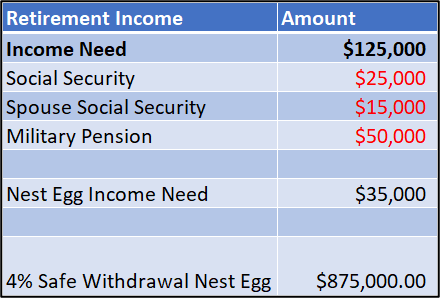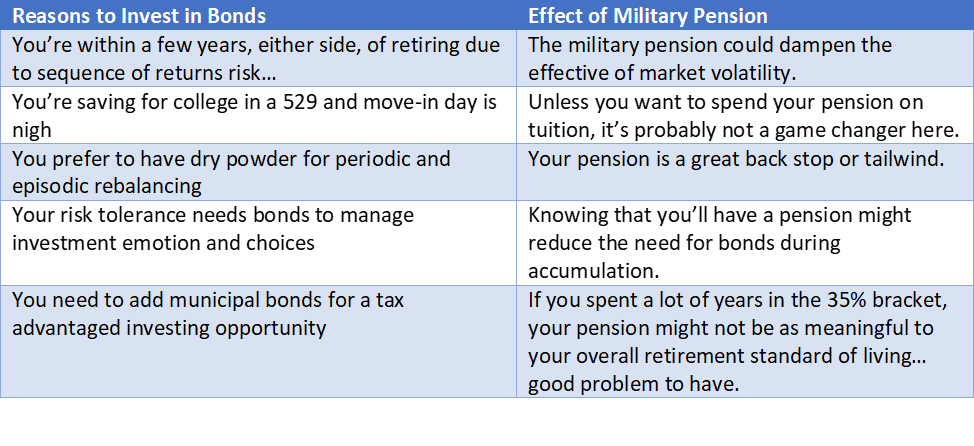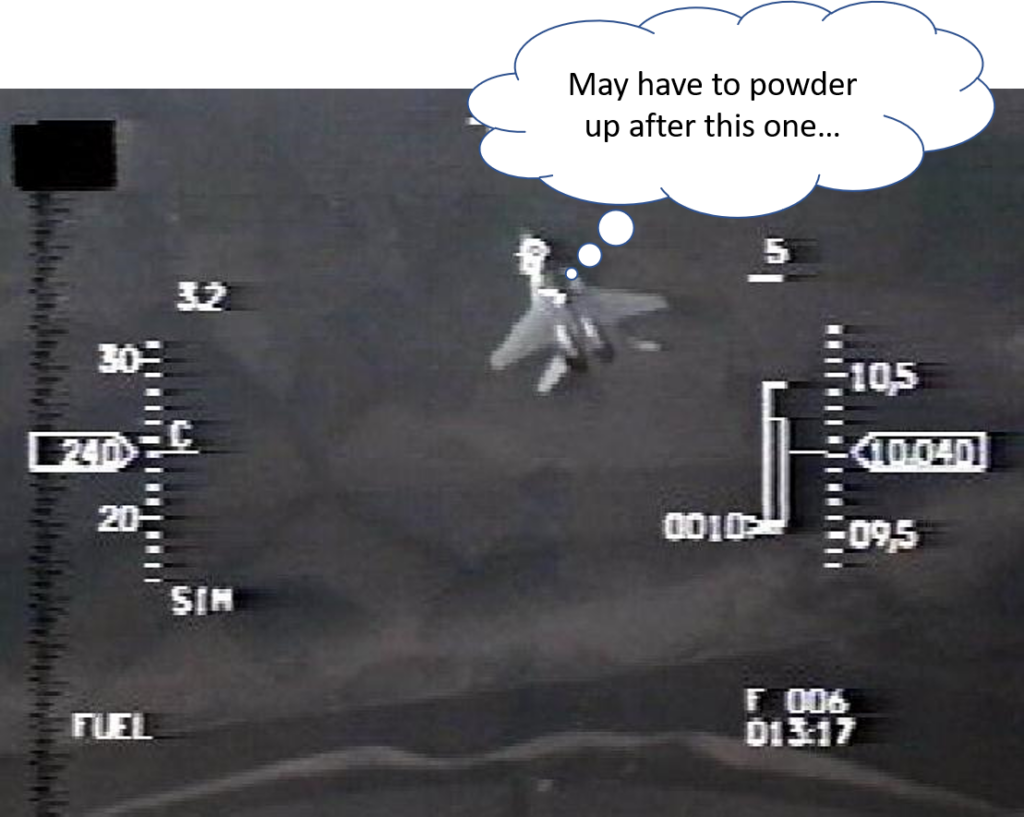Bond… Not Gold Bond… Part 2
In Part 1 of this series, we examined typical reasons why investors might or might not want bonds as part of their retirement portfolio. Common investing advice suggests that investors should increase the percentage of bonds, relative to stocks, as they age. You may have heard the rule of thumb: Your Age = Percentage of Bonds for your portfolio. As we discussed in Part 1, the choice of a bond percentage is dependent on personal factors such as risk tolerance, risk capacity, return goals, and investment behavior. But fighter pilots often end up with a military retirement pension starting as early as their forties… should this factor in bond selection? Perhaps…
In planning for retirement income, a common method is to evaluate what the nest egg will throw off in terms of returns in order to understand what income you’ll be living on. For example, a $1,000,000 nest egg invested 100% in a bond fund returning 5% should reliably throw off $50,000 per year. While that 5% isn’t guaranteed, retirees are usually going to assume some stability from bond returns. If $50K is enough retirement income, then such a portfolio could be appropriate. But what if the income need was $80,000? It might be impossible to find a fixed income investment returning 8%. Most investors would look to stocks for the additional return, and just accept the risk that comes from stock volatility. To get to $80K of income, a retiree might have to take more risk in the same $1M portfolio that has a high percentage of stocks, e.g., 70% Stock / 30% Bond. If the portfolio returns 8%– Bueno. If it returns -3%, well… poor college kid habits like reversing underwear might creep back into your penny-pinching repertoire…
However, if the investor is a fighter pilot with an inflation-pacing $50K annual retirement check, then the retirement pension has just become the equivalent of a $1M bond portfolio with a 5% yield. In order to get to $80K of income need, the investor would only need to seek a 3% return on the original $1M s/he had invested. Depending on the age and life expectancy, an all-cash portfolio might still provide enough income without any investment risk (but with serious inflation risk).
Let’s take a look at a more realistic scenario. Assume that you believe you can comfortably retire on the equivalent of $125,000 per year in today’s dollars. You won’t be funding college, paying for vulture-teenagers in your house, or writing mortgage checks anymore, right? From Table 1, we can see that with a total of $40K from social security (which gets a COLA), and $50K from a military pension (also on COLA), then there’s only a gap of $35K. If you’re retiring today and assuming a 4% “safe withdrawal rate”[1] (SWR) then the nest egg only needs $875K in it. SWR assumptions usually include a conservative 50/50 stock/bond mix earning about 5-6% which is ample to provide an initial $35K in returns.
Relitigating the Case For and Against Bonds
In Part 1, we suggested that bonds might be appropriate for you in certain cases. Table 2 takes a look at those reasons and how you might think about the effect of your military pension.
[1] https://en.wikipedia.org/wiki/Trinity_study

Table 1. Hypothetical Retirement Income Planning Numbers

Table 2. Effective of Military Pension on Reasons to Invest in Bonds

Table 3. Effect of Military Pension on Reasons not to Invest in Bonds
Likewise, we looked at reasons you might not invest in bonds. Table 3 examines the effect of your military pension on those.
The sweet spot for many fighter pilot investors might look like
- Use minimal bonds during accumulation years in order to maximize the potential for higher stock returns.
- Approaching the hold short line for retirement, increase bond ratios in order to try to protect the nest egg for the first few years of retirement. This can help calibrate your expectations of retirement income when it’s not just some ethereal concept that’s 20 years away.
- Once safely at cruise altitude a few years into retirement, start to dial back the bond percentage. Barring health issues, many retirees reduce spending as their activity level decreases in later retirement years. After you’re a few years into retirement, you’ll also know what your real consumption habits are.
Factoring a military pension into portfolio construction and stock/bond ratios requires clear-eyed assumptions before you pull the trigger.
Will you receive a pension? Could you separate early? Be forced out / RIF’d? If this happens, hopefully it’s early enough in your investing career to allow you to recalibrating your investment strategy if needed.
Survivor Benefit Plan. If your retirement assumptions include a full 50% of a 20-year base salary, but you pass early, will 55% of 50% be enough for your spouse? It’s a huge swing in the numbers and may not be enough guaranteed income for a surviving spouse.
Consumption. Not the 1800’s name for TB… What will your spending be like? Are you susceptible to the occasional bout of budget-mauling YOLO? You’ll need to really know what your family’s spending is like pre-retirement in order to account for it properly in retirement.
Bonds are generally not sexy, but ignore their effect on your investments at your peril. A military pension is a great opportunity to rethink bonds, but like all financial planning topics, there’s a lot of dimensions to consider. Hopefully this article gives you a chance to revisit your thinking on bonds and your military retirement. Fight’s on!
Winged Wealth Management and Financial Planning LLC (WWMFP) is a registered investment advisor offering advisory services in the State of Florida and in other jurisdictions where exempted. Registration does not imply a certain level of skill or training.
This communication is for informational purposes only and is not intended as tax, accounting or legal advice, as an offer or solicitation of an offer to buy or sell, or as an endorsement of any company, security, fund, or other securities or non-securities offering. This communication should not be relied upon as the sole factor in an investment making decision.
Past performance is no indication of future results. Investment in securities involves significant risk and has the potential for partial or complete loss of funds invested. It should not be assumed that any recommendations made will be profitable or equal the performance noted in this publication.
The information herein is provided “AS IS” and without warranties of any kind either express or implied. To the fullest extent permissible pursuant to applicable laws, Winged Wealth Management and Financial Planning (referred to as “WWMFP”) disclaims all warranties, express or implied, including, but not limited to, implied warranties of merchantability, non-infringement, and suitability for a particular purpose.
All opinions and estimates constitute WWMFP’s judgement as of the date of this communication and are subject to change without notice. WWMFP does not warrant that the information will be free from error. The information should not be relied upon for purposes of transacting securities or other investments. Your use of the information is at your sole risk. Under no circumstances shall WWMFP be liable for any direct, indirect, special or consequential damages that result from the use of, or the inability to use, the information provided herein, even if WWMFP or a WWMFP authorized representative has been advised of the possibility of such damages. Information contained herein should not be considered a solicitation to buy, an offer to sell, or a recommendation of any security in any jurisdiction where such offer, solicitation, or recommendation would be unlawful or unauthorized.

